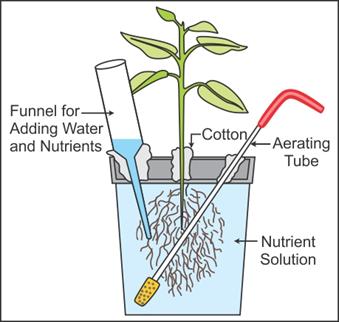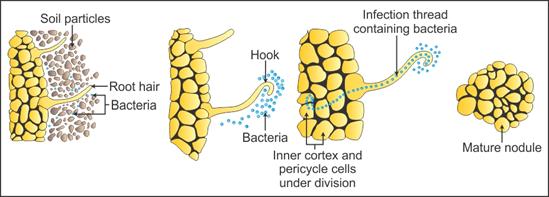Q1. Name the two amides found in plants.
Solution
Asparagine and glutamine
Q2. Define
critical concentration.
Solution
The
concentration of essential elements below which the growth of plants is
retarded is called the critical concentration.
Q3. Deficiency
of which of the following can cause yellowing of intravenous regions of
leaves?
Solution
Interveinal
chlorosis (i.e. yellowing of intravenous regions of leaves) occurs due to the
deficiency of potassium.
Q4. In cabbages, ‘Whiptail’ is a characteristic deficiency disease. It is caused by the deficiency of
Solution
In cabbages, ‘Whiptail’ is caused by the deficiency of molybdenum
which is characterised by the distortion of young leaves, a long mid-rib and
poorly developed ragged blades.
Q5. Name the
deficiency symptom in which leaves turn yellow.
Solution
Chlorosis
Q6. What is the least concentration of minerals which can be detected in plants by using modern techniques?
Solution
The least concentration of minerals which can be detected in plants by using modern techniques is 10-8 g/ml.
Q7. Which one
of the following microbes forms a symbiotic association with plants and helps
them in their nutrition.
Solution
Glomus is a fungus which forms a symbiotic
association with the roots of plants (mycorrhiza) and helps them to absorb
their nutrition.
Q8. The middle lamella mainly contains
Solution
Calcium is required for the synthesis of pectin in the middle lamella of the cell wall.
Q9. Which is essential for root hair growth?
Solution
Calcium is essential for the development of root hair as well as the root and stem apices.
Q10. Name the
element required for the photolysis of water during photosynthesis.
Solution
Manganous
ions or chlorine ions
Q11. Name the element found in plants growing near nuclear testing sites.
Solution
Radioactive Strontium
Q12. With the
help of examples explain the role of essential elements in activating or
inhibiting enzymes.
Solution
Magnesium
is an activator for ribulose bisphosphate carboxylase-oxygenase as well as
for phosphoenol pyruvate carboxylase.
Both
enzymes play an integral role in CO2 fixation in photosynthesis.
Zinc ions
activate alcohol dehydrogenase and the molybdenum of nitrogenase during
nitrogen fixation.
Q13. The deficiency of which element affects the process of photosynthesis
Solution
The deficiency of chlorine affects the process of photosynthesis as it
plays an important role in PS II during photosynthesis.
Q14. Name
parts of the plant where potassium is required in abundant quantities. State
any two functions of potassium ions in plants.
Solution
Potassium
ions are required in the meristematic tissues, buds, leaves and root tips.
Potassium
helps to maintain an anion-cation balance in cells.
Potassium
is required in all phosphorylation reactions.
Q15. Excess of
manganese induces deficiency of other elements in plants. Justify.
Solution
Many
times, excess of an element inhibits the uptake of another element by the
plant.
Manganese
when becomes toxic (i.e. present more than its required concentration) causes
brown spots to appear around the chlorotic veins.
Manganese
competes with iron for uptake.
It
competes with magnesium for binding with enzymes.
It inhibits
the calcium translocation in the shoot apex.
Hence,
excess of manganese induces deficiency of other elements in plants.
Q16. Name the
two amino acids which contain sulphur.
Solution
The two
amino acids which contain sulphur are cysteine and methionine.
Q17. Name the
following:
Aerobic
nitrogen-fixing bacteria
Anaerobic
nitrogen-fixing bacteria
Solution
Aerobic
nitrogen-fixing bacteria - Azotobacter
Anaerobic
nitrogen-fixing bacteria - Rhodospirillum
Q18. The
function of leghaemoglobin in the root nodules of legumes is
Solution
Leghaemoglobin
is a red-coloured pigment found in the root nodules of leguminous plants. It
combines with oxygen and thus helps in oxygen removal from root nodules.
Q19. What is
nitrogen fixation? State the two natural sources to provide energy for
nitrogen fixation.
Solution
The
process of conversion of nitrogen to ammonia is called nitrogen fixation.
Ultraviolet radiation and lightning provide energy for nitrogen fixation.
Q20. Name the
element which activates the enzyme nitrogenase during nitrogen metabolism.
Solution
Molybdenum
Q21. Name the element which plays an important role in biological nitrogen fixation.
Solution
Molybdenum activates the enzymes involved in nitrogen metabolism and hence plays an important role in nitrogen fixation.
Q22. Manganese in toxic concentrations leads to the deficiency of
Solution
Manganese in toxic concentrations leads to the deficiency of calcium,
iron and magnesium as it competes with iron and magnesium for nutrient
uptake.
Q23. The function of leghaemoglobin (a red pigment) in root nodules of leguminous plant is
Solution
Leghaemoglobin is a red pigment which gives a pinkish appearance to the nodules of leguminous plants. It combines with oxygen and regulates O2 supply in cells.
Q24. State the
reason due to which the minerals become available to the roots of plants.
Solution
Weathering
and break down of rocks
Q25. Name the bacterium which can produce nodules on non-leguminous Alnus.
Solution
Frankia
Q26. What are the symptoms of chlorosis? Name any six elements whose deficiency causes necrosis.
Solution
Chlorosis occurs due to a lack of chlorophyll and the leaves turn yellow.
Deficiency of nitrogen, potassium, iron, manganese, zinc and sulphur causes necrosis.
Q27. Molybdenum is the essential constituent of
Solution
Molybdenum is the essential constituent of nitrogenase enzyme. Nitrogenase is a Mo-Fe protein and catalyses the conversion of atmospheric nitrogen into ammonia.
Q28. State the role of Nitrobacter in nitrogen fixation.
Solution
Nitrobacter oxidises nitrite into nitrate.
Q29. Draw a well-labelled diagram of a typical setup of nutrient solution culture.
Solution
Typical setup of nutrient solution culture:


Q30. Describe
the importance of calcium in cell division.
Solution
Calcium
pectate is necessary for the formation of the middle lamella, a part of the cell
wall. Hence, calcium is important in the synthesis of the cell wall during
cell division.
It is
required for the formation of the mitotic spindle.
Q31. When is an
element considered toxic for plants?
Solution
Any
mineral concentration which reduces the dry weight of plant tissues by 10% is
toxic for plants.
Q32. Which one
of the following elements in plants is not remobilised?
Solution
Calcium
is an immobile element. It cannot be remobilised in plants, so its deficiency
symptoms first appear in younger tissues rather than older ones. Phosphorus,
potassium and sulphur are mobile elements. They can be remobilised in plants,
so their deficiency symptoms first appear in older tissues.
Q33. What is the name given to the movement of ions?
Solution
Flux
Q34. Write the forms in which boron is absorbed by plants.
Solution
 are the forms in which boron is absorbed by plants.
are the forms in which boron is absorbed by plants.
Q35. Name any
one bacterium which oxidises ammonia to nitrite.
Solution
Nitrosomonas/Nitrococcus
Q36. Name the
enzyme for which Zn2+ acts as an activator.
Solution
Alcohol
dehydrogenase
Q37. Which
plant tissues die in necrosis?
Solution
Leaf
tissues
Q38. Name the
vegetables which are produced commercially by using hydroponics.
Solution
Seedless
cucumber, tomato and lettuce
Q39. State the
criteria which decide the essentiality of elements.
Solution
Criteria which decide the
essentiality of elements:
The
element must be necessary for plant growth and reproduction. In the absence
of such elements, plants do not complete their lifecycles.
The
deficiency of the element cannot be met by supplying some other element.
The
element must be directly involved in plant metabolism.
Q40. Which
element is responsible for the opening and closing of stomata to some extent?
Solution
Potassium
Q41. Name the first phase of uptake of ions in the outer space of cells.
Solution
Apoplast
Q42. Name the elements whose deficiencies are visible in senescent leaves.
Solution
Nitrogen, potassium and magnesium
Q43. Name the elements responsible for the following functions:
Maintenance of the ribosome structure
Activation of catalase
Germination of pollen grains
Photolysis of water
Solution
Maintenance of the ribosome structure - Magnesium
Activation of catalase - Iron
Germination of pollen grains - Boron
Photolysis of water - Chlorine
Q44. Explain
the method of hydroponics.
Solution
In
hydroponics, a series of experiments are conducted in which roots of plants
are immersed in a nutrient solution.
Then an
element is either added or removed or provided in varied concentration in the
solution according to its suitability to the plant and its growth.
Plants
are grown in tubes or troughs placed at a slight incline.
A pump is
provided which circulates the solution from a reservoir to the elevated end
of the tube.
The
solution flows down the tubes and returns back to the reservoir.
The roots
of the plants get bathed continuously in an aerated solution.
Q45. Represent diagrammatically the development of root nodules in soyabean.
Solution
Development of root nodules in soyabean:


Q46. Write the chemical equations of the two steps involved in the conversion of ammonia to nitrates.
Solution
Step one: Ammonia to nitrite ions
 Step two: Nitrites to nitrate ions
Step two: Nitrites to nitrate ions

 Step two: Nitrites to nitrate ions
Step two: Nitrites to nitrate ions

Q47. Name the
technique of growing plants in a nutrient solution.
Solution
Hydroponics
is the technique of growing plants in a nutrient solution.
Q48. Name the
parts of the plants which require potassium ions more abundantly.
Solution
Meristematic
tissues, buds, leaves and root tips require potassium abundantly.
Q49. What did Julius von Sachs demonstrate?
Solution
Julius von Sachs demonstrated that plants could be grown in a defined medium in the complete absence of soil and such plants also attain maturity.
Q50. What is
denitrification? Name the bacteria which perform denitrification.
Solution
Reduction
of nitrate present in the soil into nitrogen is called denitrification.
Bacteria Pseudomonas and Thiobacillus perform denitrification.
Q51. Name the compound which when reacts with ammonia forms glutamic aid.
Solution
α-ketoglutaric acid
Q52. Name the
element essential for the synthesis of auxin.
Solution
Zinc ions
are required for the synthesis of auxin.
Q53. Represent
diagrammatically the relationship between atmospheric, soil and biomass
nitrogen pool during the nitrogen cycle.
Solution

Comments
Post a Comment